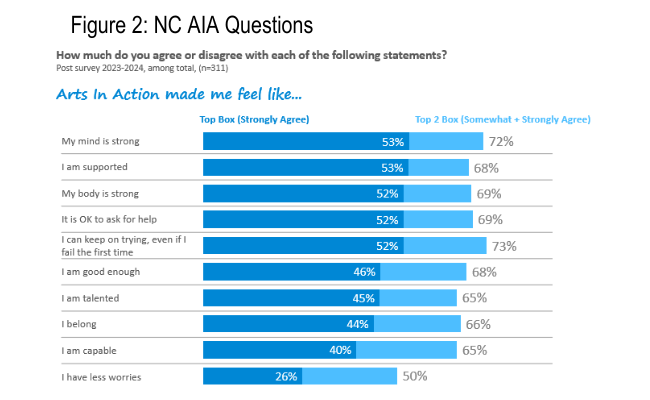North Carolina Arts in Action uses data to share the impact of its program
Editor’s note: Laura Bayzle is managing partner at The Link Group. Andrew Hunt, senior research director, and Shep Zoutewelle, senior research manager, The Link Group, also contributed to this article.
We walk into the elementary school gym to the sounds of musicians drumming the bongo and tapping out a jazzy rhythm on a keyboard. In the center of the gym, a classroom of fourth graders imitates the moves of a North Carolina Arts in Action (NC AIA) dance teacher, creating a dance to the musical rhythms.
“I go first, then you go,” the teacher directs as she demonstrates the eight-count choreography. The moves themselves are not complicated: her hands smack on the tops of her thighs for four counts and then she does “crispy fingers” (jazz hands) to the remaining beats. “Let me see your crispy fingers!” The children follow her lead, and she goes around to each, checking to see how crispy their fingers are. If they need more crispiness, she provides direction and they correct.
Another time, she brings attention to a quieter student who is nailing the choreography. “Sam, you are doing a great job erupting.” (The children are learning about volcanoes and the NC AIA choreography ties to the science subject matter.) “Can you show the rest of the class the energy you bring when erupting?” All eyes are on Sam, who blushes slightly, as he demonstrates. The class claps and Sam’s eyes shine. The quiet, shy child has had his moment to stand out and be recognized by his peers.
By the end of the class, the children have learned the eight-count choreography, the first of several sets of choreography they will learn over the next 16 weeks. At the end, they will bring it all together in a performance for their parents and the rest of the school.
The choreography is tied to their science curriculum for this semester. This helps reinforce their classroom learning with body movement and music. But the children have learned much more in the past 45 minutes. Using the NC AIA pedagogy, the children are also learning self-confidence, resiliency and supporting their fellow classmates. This in-school dance residency – primarily in Title 1 schools in North Carolina – empowers students and teaches them life skills through dance and music.
Survey research expands donor engagement and boosts fundraising success
But can you objectively measure the impact that dance and music have on a child’s ability and school performance? Over the past seven years, we have partnered with NC AIA to do just that. And the results have been astounding.
We have seen that the program significantly improves math and social studies performance, when analyzing grades at the school district level. And in pre- and post-survey data, we see significant improvement in self-confidence, attitudes about school and attention paid in class.
Showing this data is powerful for both schools and donors. NC AIA uses this data to tell a story about the impact of its program to help raise money and expand into more schools.
Last year, we were poised to continue the same survey again. But after seven years, it was time to look at the survey with fresh eyes. We challenged the team – and ourselves – to ask, “Is there more to the story?” “Is there a different story to tell?”
At this point, NC AIA had veteran teachers, which meant that the impact they were having on students may have evolved since we first started measuring the program. And it felt that a new and refreshed message to donors may expand their audience and engage their current donors at a different level.
Refreshing trackers: Build, maintain, reframe, remove
We recommend that everyone who conducts trackers pause and refresh their trackers from time to time. Invariably, there will be questions left in the survey that no longer make sense or are no longer impactful, there may be blind spots we need to address with new questions and there may be opportunity to reframe questions to better align with program objectives.
For NC AIA, we created the donor impact framework (Figure 1), which measures the attractiveness of key metrics to donors against the focus areas of the program.

We checked in with donors (both individual donors and foundations) to understand what was most important to them and what impacted their consideration to give (donor focus). That became our yardstick against which “success” and impact were measured. We then focused on NC AIA’s mission and what they cared about most when it came to serving children (program focus).
Taking a moment to realign on both axis – donor focus and program focus – proved to be important. Over the past seven years, NC AIA had refined its mission, which meant some of the questions we were asking students were no longer relevant to NC AIA’s cause. And over time, donors had a new focus on areas that mattered most to them.
Build. For example, we found that coming out of the pandemic, donors were focused more on social-emotional behavior and mental health than ever before. While questions in the survey addressed these areas to a certain degree, we found that we could build new questions around this donor focus that really narrowed in to measure this impact. While social-emotional behavior is not a core focus for NC AIA, it is related to its mission to “teach children life skills through dance and music.” As a result, we built a new battery of 10 questions that asked students how much they agreed or disagreed with each statement (Figure 2).

Remove. On the other end, we found there was a question – how do you feel about exercising – that was no longer relevant. Seven years ago, the focus was on physical health and so at the time this question was important to show how the program may reframe mind-set around exercise. Today, it wasn’t important to donors and wasn’t a core tenant of the program. So, we removed this question.
Maintain. There were several questions that were important to continue to measure because they were important to donors and were also core to NC AIA’s mission. So, we continued to keep in questions that measured impact on self-confidence, the amount that children felt they could accomplish in school and how much attention they paid in class.
Reframe. And lastly, we identified two questions to reframe. They centered around how students felt about going to class and how they felt about their program instructors. We found they were an important area for the program to measure, but less important for donors. We reframed the questions in a way that may increase interest among donors.
Creating a streamlined, timely survey
By taking time to refresh NC AIA’s tracker and using the donor impact framework, we were able to create a more streamlined and timely survey. This means that NC AIA can better measure impact of their program in a way that is meaningful not only for their donors, but also for their program. And at a higher level, it allows society to see how dance and music influence and positively change student’s lives.
Keeping your trackers crispy
When was the last time you looked at your trackers? How “crispy” are they? Bring a fresh eye to them and use a framework that fits with your objectives. Determine how current questions align with your organization’s focus, as well as the focus of your audience. And from there identify those questions and question areas to build, maintain, reframe and remove.
